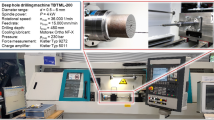Abstract
One of the most challenging machining operation, particularly with regard to the difficult chip evacuation, is the deep-hole drilling process. Due to the high length-to-diameter ratio of the drill holes and of the tools no complete dry machining is possible, thus minimum quantity lubrication is used to provide a lubrication film at the contact surface of the tribological partners and to ensure a reliable chip removal capability. This paper presents a fundamental comparison of the in-process heat input into the workpiece and the resulting straightness deviations for two different tool concepts—a single-lip drill and a twist drill. In particular, the deep-hole drilling of components with small wall thicknesses, down to a minimum value of \({s_{{\mathrm {w}}}} = 1\, \hbox {mm}\), was analysed to gather information about the mechanisms leading to straightness deviations. Due to the conclusions, particularly using a single-lip drill, a novel experimental approach for the determination of the force distribution over the drill radius was developed. It enables the incremental force measurement along the cutting edge and has been used to generate input data for a finite element analysis of the tool deflection and the contact conditions between tool and workpiece. The results indicate that the single-lip drill is a competitive alternative to the twist drill, but the asymmetric cutting edge design and the required guide pad support limit its productivity, in particular with regard to the heat input and the straightness deviation in the manufacturing of drill holes in thin-walled workpieces.












Similar content being viewed by others
References
Weinert K, Inasaki I, Sutherland JW, Wakabayashi T (2004) Dry machining and minimum quantity lubrication. CIRP Ann Manuf Technol 53/2:511–537
Klocke F, Eisenblätter G (1997) Dry cutting. CIRP Ann Manuf Technol 46/2:519–526
Byrne G, Dornfeld D, Denkena B (2003) Advancing cutting technology. CIRP Ann Manuf Technol 52/2:483–507
Duflou JR, Sutherland JW, Dornfeld D, Herrmann C, Jeswiet J, Kara S, Hauschild M, Kellens K (2012) Towards energy and resource efficient manufacturing: a processes and systems approach. CIRP Ann Manuf Technol 61/2:587–609
Tai BL, Stephenson DA, Furness RJ, Shih AJ (2014) Minimum quantity lubrication (MQL) in automotive powertrain machining. In: Proceedings of the 6th CIRP international conference on high performance cutting, HPC2014, Procedia CIRP, 14:523–528
Heisel U, Wallaschek J, Eisseler R, Potthast C (2008) Ultrasonic deep hole drilling in electrolytic copper ECu 57. CIRP Ann Manuf Technol 57/1:53–56
Eisseler R (2010) Verbesserung der Prozessbedingungen beim Einlippentiefbohren durch unterschiedliche Formen der Vorschubmodulation. In: Braun S, Maier W, Zirkelbach S (eds) Intelligent produzieren - Liber amicorum. Springer, Berlin, pp 77–87. ISBN 978-3-642-13101-1
Radkowitsch W, Metzner K, Bleicher F, Bernreiter J, Einspieler C (2006) Gerichtetes Einlippen-Tieflochbohren, VDI-Berichte Nr. 1897, Tagung Präzisions- und Tiefbohren aktuell, Dortmund
Enderle KD (1993) Reduzierung des Mittenverlaufs durch Kühlmittelpulsation beim Einlippentiefbohren, Ph.D. Thesis, University of Stuttgart
Kessler N (2011) Thermische Mittenverlaufsbeeinflussung beim BTA-Tiefbohren, Ph.D. Thesis, TU Dortmund University
Acknowledgments
This paper is based on investigations conducted in the project “Experimental and FE-based analysis of the thermal load on the tool and the workpiece in deep hole drilling using twist drills” (BI 498/24-3), which is kindly funded by the German Research Foundation (DFG) within the framework of the priority programme 1480 “Modelling, Simulation and Compensation of Thermal Effects for Complex Machining Processes”.
Author information
Authors and Affiliations
Corresponding author
Rights and permissions
About this article
Cite this article
Biermann, D., Iovkov, I. Investigations on the formation of straightness deviation in MQL deep-hole drilling of thin-walled aluminium components. Prod. Eng. Res. Devel. 9, 527–535 (2015). https://doi.org/10.1007/s11740-015-0632-9
Received:
Accepted:
Published:
Issue Date:
DOI: https://doi.org/10.1007/s11740-015-0632-9




